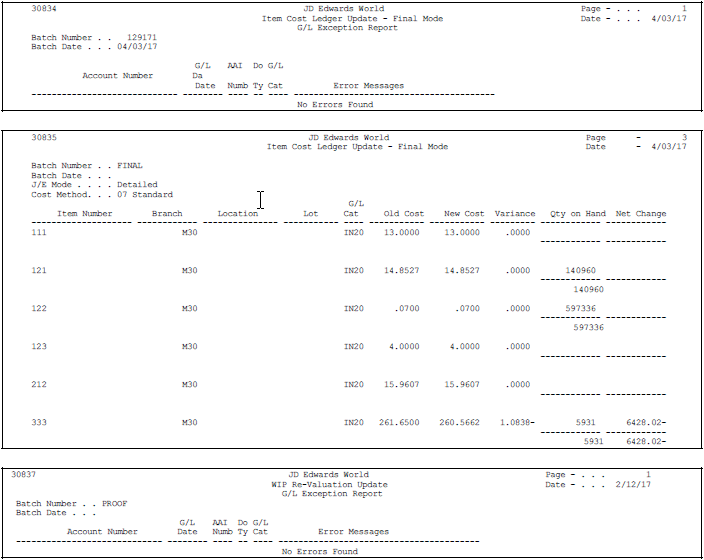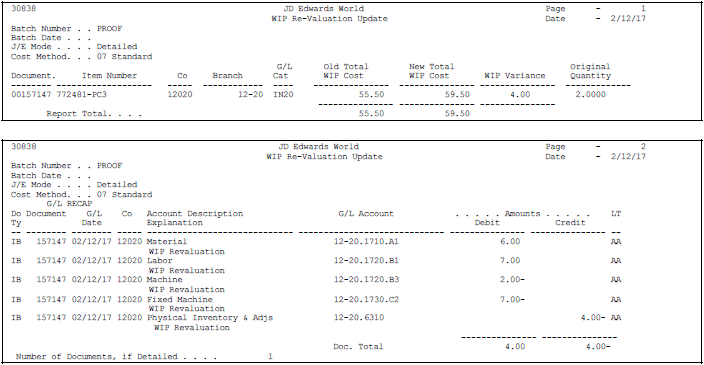8 Update Frozen Costs
This chapter contains the topic:
8.1 Updating Frozen Costs
From Manufacturing Systems (G3), choose Product Costing
From Daily Product Costing (G3014), choose Frozen Update or Frozen Update/WIP Revaluation
After you perform simulated rollups to determine the effect of changes, you can update your frozen costs with simulated values by running a frozen update. Most companies run this program at the beginning of a new fiscal year to create their manufacturing costs for the next fiscal period.
You can perform simulated rollups and frozen updates for any cost method, except 02. The Manufacturing Accounting system uses frozen standard costs (method 07), unless Actual Cost is indicated for the Manufactured item.
Note:
This program uses the costs generated by the most recent run of the Simulate Cost Rollup program. If you have changed information since the last simulated cost rollup, those changes will not be reflected by the frozen update.The Frozen Update program uses the costs that were generated by the Simulate Cost Rollup program to:
-
Update unit costs in the Cost Ledger table (F4105) for the cost method selected
-
Update frozen costs in the Cost Components table (F30026) for the cost method selected
-
Update labor and overhead rates, for the cost method selected, in the Work Center Master table (F30006)
-
Print report totals by company, branch/plant, and G/L category code
-
For on-hand balances, create an Item Balance (IB) record in the Item Ledger table (F4111) if the cost method selected matches the sales/inventory cost method for an item, and a journal entry if a net change in value exists.
-
For on-hand balances, write journal entries to the Account Ledger table (F0911) in either detail or summary format
An item ledger record is written if the cost method selected for update is the standard (07) cost method or the sales/inventory cost method. The item ledger record indicates a change in inventory value for the updated items. The number of item ledger records written depends on the cost level of the item, which is defined in the Item Master table (F4101). For example, items at cost level 2 would have an item ledger record for each branch/plant at which they are defined, because costs can differ by branch/plant.
For cost level 3, an item ledger record is written for each lot/location.
In addition, if you set the processing option, the program does the following for work in process (WIP Revaluation):
-
Adjusts inventory values in the Production Cost File (F3102) for any open orders
-
Writes journal entries to the Account Ledger table (F0911) in either detail or summary format
Costs in the Production Cost File (F3102) are updated for those open work orders affected by a cost change. In other words:
-
The program creates a journal entry only if a work order has an outstanding WIP balance.
-
WIP costs are only updated for open work orders (variance flag is less than 3)
-
The work order is updated only if it contains an item selected for cost update.
Standard, completed, and scrapped costs are updated using the new parent frozen costs. Current, planned, and actual costs are updated using the new component costs and work center rates (simulated in proof mode and frozen in final mode).
8.1.1 Journal Entries for On-Hand Balances
The program creates journal entries in either detail or summary format that match in amount with the item ledger records. Thus the program maintains integrity between the Item Ledger and the Account Ledger. Use the Item Ledger/Account Integrity report to verify this integrity.
The process flow is as follows:
-
The program creates a journal entry only if an item ledger record has been written.
-
An item ledger record is written only if an item cost ledger record has been updated.
-
An item cost ledger record is updated only if a cost component record has been updated.
The program accesses the following AAIs to obtain the object account.
| AAI Table Number | Description | Use |
|---|---|---|
| 4134 | Inventory | Debit to show increase in item cost
Credit to show decrease in item cost |
| 4136 | Expense or COGS | Debit to show expense or loss
Credit to show income or gain |
8.1.1.1 Detail Journal Entries
If you choose detail format, the program creates matching debit and credit account ledger records for every item ledger record created. Use the detail format when you want a detailed audit trail.
8.1.1.2 Summary Journal Entries
If you choose summary format, the program creates debit and credit records by subtotals of company, general ledger category code, and transaction type. Use the summary format to reduce the amount of detail in the general ledger. You can select to run summary journal entries with a detailed report.
Caution:
Consider the memory allocation requirements, as the potential volume can be quite large.8.1.2 Journal Entries for WIP Revaluation
The program creates journal entries in either detail or summary format that match in amount with the work order costs. Thus the program maintains integrity between the WIP balances and the Account Ledger. Use Variance Inquiry to verify this integrity.
The program accesses the following DMAAIs to obtain the object account.
| DMAAI Table Number | Description | Use |
|---|---|---|
| 4136 | Expense or COGS | Debit to show expense or loss
Credit to show income or gain |
| 3120 | WIP | Debit to show increase in WIP costs
Credit to show decrease in WIP costs |
Note:
If not familiar with the WIP Revaluation process and impact, consider using a test environment and/or running in Proof mode first.8.1.2.1 Detail Journal Entries
If you choose detail format, the program creates matching debit and credit account ledger records for every updated work order. Use the detail format when you want a detailed audit trail. However, consider that the potential volume is large, requiring a lot of memory. If running in detail mode, the work order number can be written to the GL detail Subledger field facilitating research. It is advisable to run the proof in detail mode, followed by a summary mode run.
8.1.2.2 Summary Journal Entries
If you choose summary format, the program creates debit and credit records by subtotals of company, general ledger category code, and transaction type. Use the summary format to reduce the amount of detail in the general ledger. You can still run a report as a detailed audit trail.
8.1.3 Before You Begin
-
Ensure that you have set up item cost levels on the initial Item Master Information form. See Section 3.3, "Setting Up Item Cost Levels."
8.1.4 What You Should Know About
| Topic | Description |
|---|---|
| Ensuring Manufacturing Work Orders are Closed | For a manufacturing work order to be considered closed, the variance flag (PPFG) on the work order header must have a value of 3. To achieve this, set the processing options on the variance program as follows:
#9 – Enter a value greater than or equal to 11. Note: A World Writer report is available on the Manufacturing Accounting Periodic menu (G3123) to locate work orders where the variance flag values are less than 3: ZJDE0013 Variance Flag Exceptions. |
| Flex Accounting for Frozen Cost Update | You can determine the impact of Flex Accounting when generating journal entries for product cost update. |
| Flex Accounting for WIP Revaluation | You can use Flex Accounting when generating journal entries for WIP Revaluation. |
| Configurator Work Orders | Configurator Work Orders are included in WIP Revaluation. These are work orders for stocking type C parent items. |
8.1.5 Reports
The program produces the following reports:
Figure 8-1 Item Cost Ledger Exception report

Description of "Figure 8-1 Item Cost Ledger Exception report"
Figure 8-2 Variance Flag Exceptions report

Description of "Figure 8-2 Variance Flag Exceptions report"
See Also:
-
Section 18.1, "Creating Journal Entries" for more information on detail and summary journal entries,
-
Section 20.5, "Reviewing the Item Ledger/Account Integrity Report."
